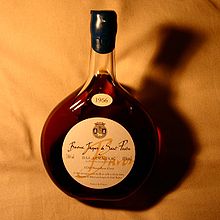| Baco blanc | |
|---|---|
| Grape (Vitis) | |
 A bottle of 1956 Armagnac made when Baco blanc was the primary grape variety of the region | |
| Color of berry skin | Blanc |
| Species | Interspecific crossing (French-American hybrid) |
| Also called | see list of synonyms |
| Notable wines | Armagnac |
| VIVC number | 868 |
Baco blanc or Baco 22A is a French-American hybrid grape variety. It is a cross of Folle blanche and the Noah grape, created in 1898 by the grape breeder François Baco.[1] Folle blanche is its Vitis vinifera parent. Noah, its other parent, is itself a cross of Vitis labrusca and Vitis riparia.[2]
Baco blanc was developed to produce some of the same flavors as Folle blanche but without the susceptibility to American grape disease and phylloxera. In the 20th century it was widely planted in the Gascony region for uses in brandy production. Both Armagnac and Cognac (from the Charentes and Charente-Maritime districts north of Gascony) are brandies made from white grapes – Ugni blanc, Folle blanche and Colombard – but only Armagnac was permitted under French regulations to use Baco blanc and until the late 1970s, Baco blanc was the primary grape of Armagnac.[2][3]
Following the grape's decline in the late 20th century, there was some speculation about the future of the variety, especially after a 1992 Institut National des Appellations d'Origine (INAO) decree that all vines of Baco blanc were to be uprooted by 2010. However, advocates for the grape variety and its historical role in Armagnac were able to persuade French authorities to continue permitting its use in the distilled wines from the Armagnac region.[4]
- ^ Cite error: The named reference
VIVCwas invoked but never defined (see the help page). - ^ a b J. Robinson Jancis Robinson's Guide to Wine Grapes pg 27 Oxford University Press 1996 ISBN 0-19-860098-4
- ^ Oz Clarke Encyclopedia of Grapes pg 39 Harcourt Books 2001 ISBN 0-15-100714-4
- ^ Harper's Wine and Spirits "Baco to the Future Archived 2011-10-02 at the Wayback Machine" July 14th 2005